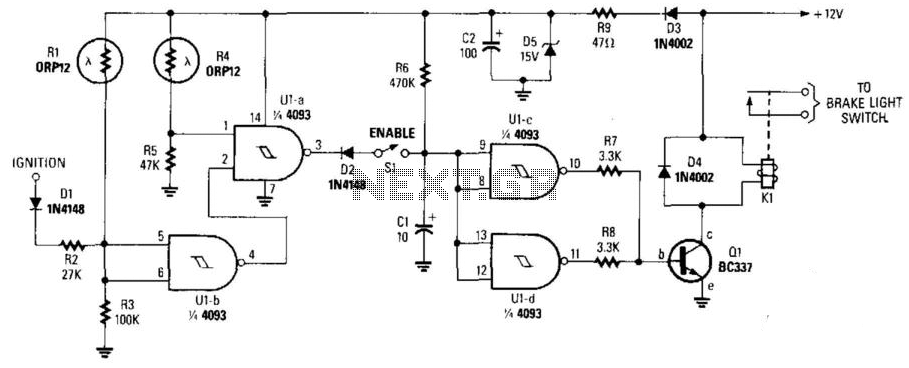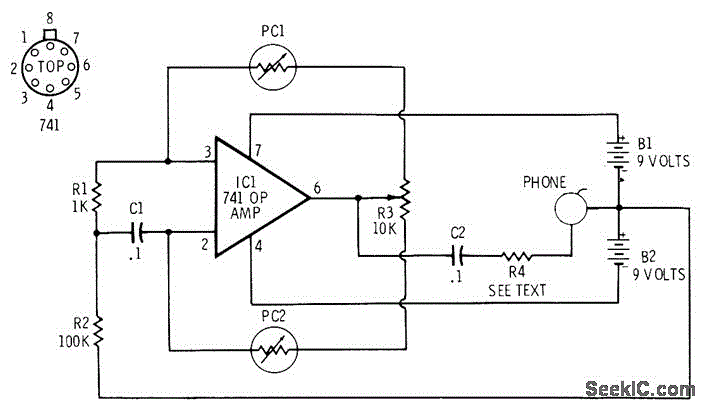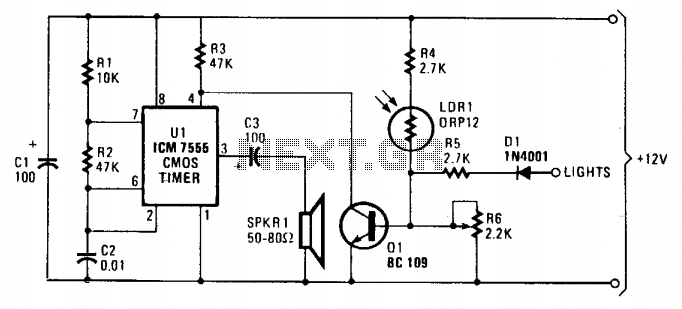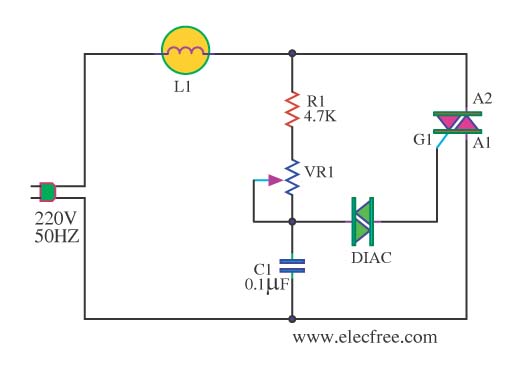
Night Safety Light For Autos

This circuit activates the brake lights of a parked car when headlights from an approaching vehicle are detected, alerting the driver of the oncoming vehicle about the stationary car. LDR4 serves as the sensor, while LDR1 deactivates the circuit by pulling the input of Ul gate high during daylight hours, resulting in pin 2 of Ula being low, which disables both Ula and the circuit.
The described circuit employs two light-dependent resistors (LDRs) to manage the operation of the brake lights in response to ambient light conditions and the presence of oncoming headlights. LDR1 is positioned to detect ambient light levels. During daylight, LDR1's resistance decreases, causing a high signal to be fed into the Ul gate. This high signal effectively disables the subsequent stages of the circuit, including Ula, which prevents the brake lights from activating unnecessarily during the day.
LDR4, on the other hand, is strategically placed to sense the headlights of approaching vehicles. When LDR4 detects a significant increase in light intensity, indicative of an oncoming car's headlights, its resistance drops, triggering a response in the circuit. This response can be designed to activate a relay or a transistor that connects the brake lights to the vehicle's power supply, illuminating them to warn the oncoming driver.
The integration of these components allows for an automatic response to environmental conditions, enhancing safety by ensuring that the parked vehicle is visible to other drivers at night or in low-light conditions. The design also includes necessary safety features, such as ensuring that the circuit remains inactive during the day, preventing unnecessary power consumption and potential confusion for other drivers.
Further considerations in the design may include the selection of appropriate values for the LDRs and any associated resistors to ensure optimal sensitivity and response times. Additionally, the circuit could be enhanced with a delay mechanism to prevent the brake lights from flickering in response to transient light changes, providing a more stable indication to approaching vehicles. This circuit turns on the brake lights of a parked car when the headlights of an oncoming car are detected, wa rning the driver of the oncoming car about the parked vehicle. LDR4 is the sensor. LDR1 disables the circuit by causing Ul gate input to be pulled high during daylight hours, causing pin 2 of Ula to become low, disabling it and the circuit.
The described circuit employs two light-dependent resistors (LDRs) to manage the operation of the brake lights in response to ambient light conditions and the presence of oncoming headlights. LDR1 is positioned to detect ambient light levels. During daylight, LDR1's resistance decreases, causing a high signal to be fed into the Ul gate. This high signal effectively disables the subsequent stages of the circuit, including Ula, which prevents the brake lights from activating unnecessarily during the day.
LDR4, on the other hand, is strategically placed to sense the headlights of approaching vehicles. When LDR4 detects a significant increase in light intensity, indicative of an oncoming car's headlights, its resistance drops, triggering a response in the circuit. This response can be designed to activate a relay or a transistor that connects the brake lights to the vehicle's power supply, illuminating them to warn the oncoming driver.
The integration of these components allows for an automatic response to environmental conditions, enhancing safety by ensuring that the parked vehicle is visible to other drivers at night or in low-light conditions. The design also includes necessary safety features, such as ensuring that the circuit remains inactive during the day, preventing unnecessary power consumption and potential confusion for other drivers.
Further considerations in the design may include the selection of appropriate values for the LDRs and any associated resistors to ensure optimal sensitivity and response times. Additionally, the circuit could be enhanced with a delay mechanism to prevent the brake lights from flickering in response to transient light changes, providing a more stable indication to approaching vehicles. This circuit turns on the brake lights of a parked car when the headlights of an oncoming car are detected, wa rning the driver of the oncoming car about the parked vehicle. LDR4 is the sensor. LDR1 disables the circuit by causing Ul gate input to be pulled high during daylight hours, causing pin 2 of Ula to become low, disabling it and the circuit.





